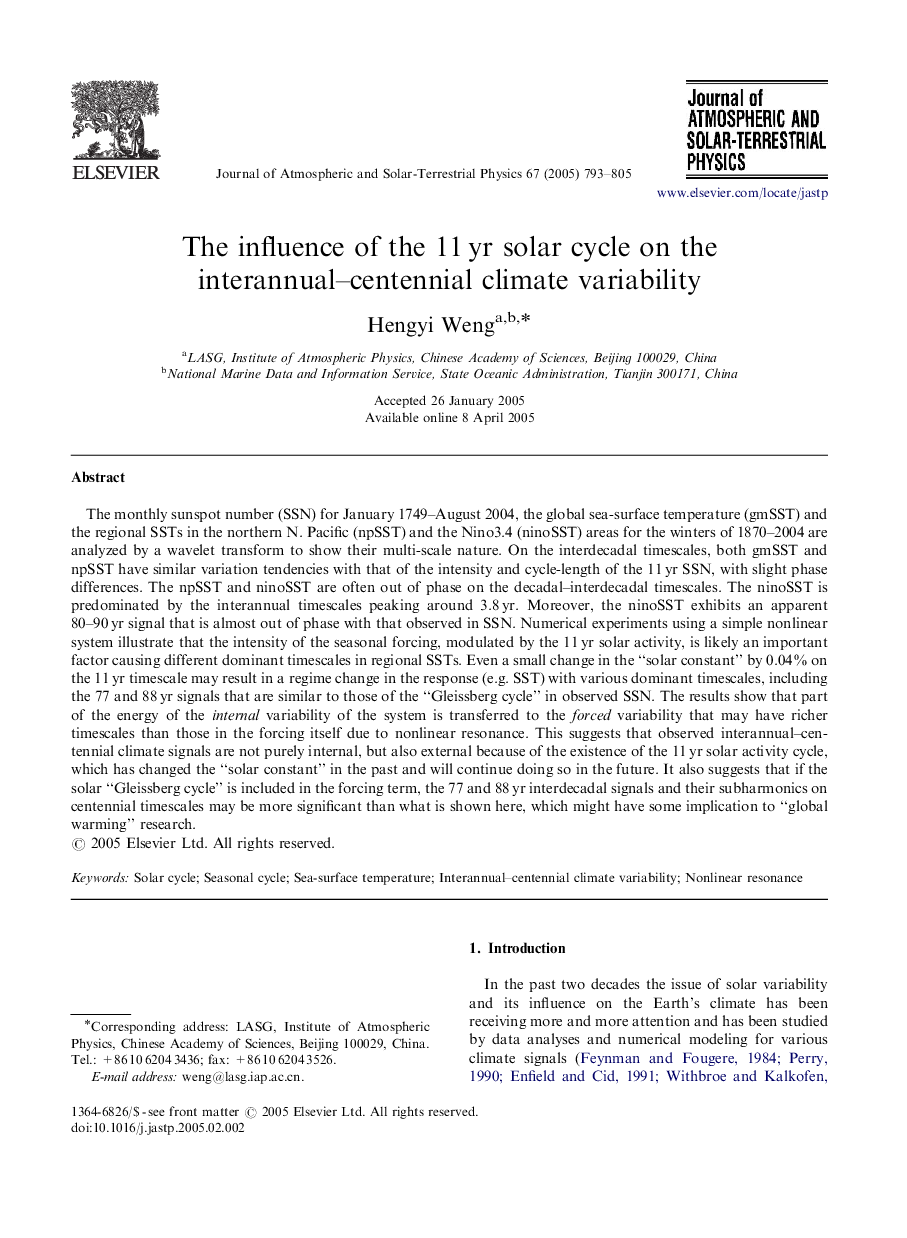| کد مقاله | کد نشریه | سال انتشار | مقاله انگلیسی | نسخه تمام متن |
|---|---|---|---|---|
| 9827703 | 1523684 | 2005 | 13 صفحه PDF | دانلود رایگان |
عنوان انگلیسی مقاله ISI
The influence of the 11Â yr solar cycle on the interannual-centennial climate variability
دانلود مقاله + سفارش ترجمه
دانلود مقاله ISI انگلیسی
رایگان برای ایرانیان
کلمات کلیدی
موضوعات مرتبط
مهندسی و علوم پایه
علوم زمین و سیارات
فیزیک زمین (ژئو فیزیک)
پیش نمایش صفحه اول مقاله

چکیده انگلیسی
The monthly sunspot number (SSN) for January 1749-August 2004, the global sea-surface temperature (gmSST) and the regional SSTs in the northern N. Pacific (npSST) and the Nino3.4 (ninoSST) areas for the winters of 1870-2004 are analyzed by a wavelet transform to show their multi-scale nature. On the interdecadal timescales, both gmSST and npSST have similar variation tendencies with that of the intensity and cycle-length of the 11Â yr SSN, with slight phase differences. The npSST and ninoSST are often out of phase on the decadal-interdecadal timescales. The ninoSST is predominated by the interannual timescales peaking around 3.8Â yr. Moreover, the ninoSST exhibits an apparent 80-90Â yr signal that is almost out of phase with that observed in SSN. Numerical experiments using a simple nonlinear system illustrate that the intensity of the seasonal forcing, modulated by the 11Â yr solar activity, is likely an important factor causing different dominant timescales in regional SSTs. Even a small change in the “solar constant” by 0.04% on the 11Â yr timescale may result in a regime change in the response (e.g. SST) with various dominant timescales, including the 77 and 88Â yr signals that are similar to those of the “Gleissberg cycle” in observed SSN. The results show that part of the energy of the internal variability of the system is transferred to the forced variability that may have richer timescales than those in the forcing itself due to nonlinear resonance. This suggests that observed interannual-centennial climate signals are not purely internal, but also external because of the existence of the 11Â yr solar activity cycle, which has changed the “solar constant” in the past and will continue doing so in the future. It also suggests that if the solar “Gleissberg cycle” is included in the forcing term, the 77 and 88Â yr interdecadal signals and their subharmonics on centennial timescales may be more significant than what is shown here, which might have some implication to “global warming” research.
ناشر
Database: Elsevier - ScienceDirect (ساینس دایرکت)
Journal: Journal of Atmospheric and Solar-Terrestrial Physics - Volume 67, Issues 8â9, MayâJune 2005, Pages 793-805
Journal: Journal of Atmospheric and Solar-Terrestrial Physics - Volume 67, Issues 8â9, MayâJune 2005, Pages 793-805
نویسندگان
Hengyi Weng,